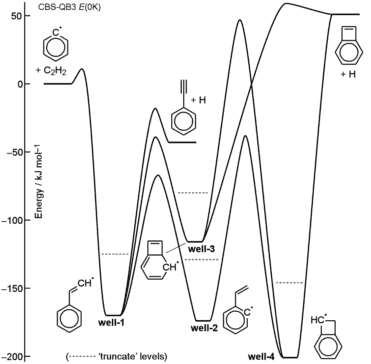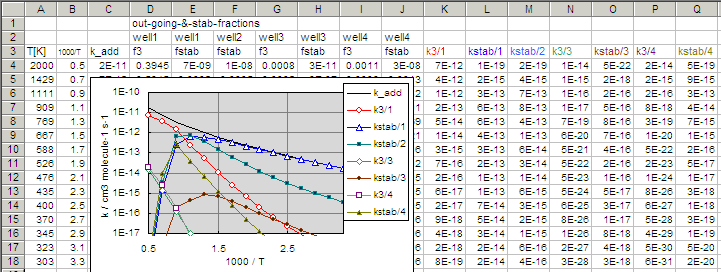- the direct ring-closure to well-3 followed by the dissociation to benzocyclobutadiene + H,
- and H-transfer to well-2 followed by the ring-closure to well-4 and dissociation.

Fig. Q2
Example problem-3
The first example for this multiple-well system is the chemical
activation problem starting from phenyl radical +
C2H2 channel.
Four MASTER input files containing ρ(E) and k(E)
can be found in the sample directory (
rc2h2ph_mwX_mas.dat,
X = 1, 2, 3, and 4). They were created by
rrkmth program except for the one for well-4, in which the last
channel do not have a pronounced barrier and k(E) for this
channel was calculated according to the microcanonical VTST using the
rdmas and frmmas tools.
Control input
The contents of the control input file,
rc2h2ph_m_ca.inp,
is shown below.
# phenyl-c2h2 quadruple-well model - chemical activation
tempRecipRange 100000 50 331 20
pressUnit atm
pressList 10
well{
index 1
filename rc2h2ph_mw1_mas
offset 27
recombChan 4
connect 2 1 ! connect to well-2 via channel-1
connect 3 2 ! connect to well-3 via channel-2
truncate 38
}
well{
index 2
filename rc2h2ph_mw2_mas
offset 23
connect 1 1 ! connect to well-1 via channel-1
connect 4 2 ! connect to well-4 via channel-2
truncate 38
}
well{
index 3
filename rc2h2ph_mw3_mas
offset 71
connect 1 1 ! connect to well-1 via channel-1
connect 4 2 ! connect to well-4 via channel-2
truncate 30
}
well{
index 4
filename rc2h2ph_mw4_mas
offset 0
connect 2 1 ! connect to well-2 via channel-1
connect 3 2 ! connect to well-2 via channel-2
truncate 46
}
The first few lines contains a comment, temperatures and pressures for
calculation similar to the previous examples. In the
well{...} block, new keywords appear to specify the relations
between the wells.
- The key
indexis used to number the well, connectis used to specify how wells are connected via isomerization channels, andoffsetis used to tell the program how much (in energy grain unit) the bottom of the well is offset.
Solving master-equation for multiple-well chemical
activation problem
- Run carate as:
(This may take a minute.)
carate rc2h2ph_m_ca > rc2h2ph_m_ca_carate.log
- The file,
rc2h2ph_m_ca_carate_out.csv, contains the essential results of calculations as shown below.

- As in the previous example (example-1), the required output is usually
the branching fractions, which can be found in the block
of columns indicated by
'out-going-&-stab-fractions'(shown above). The rest of the output consists of the blocks named,'out-going-&-stab-rates','internal-rates', and'internal-populations'(shown above), which may not be of interest as results, but may be useful for diagnostic and analysis. - Since the entrance (activation) channel is the same as in example-1,
the required bimolecular rate coefficients can be also calculated by
multiplying the high-pressure limiting rate constants found in
r_add.csvinsample/gpopdirectory. The results should look like:
- Again, it should be noted in order to avoid misunderstanding that the
rate coefficients found in the
block
'out-going-&-stab-rates'are the unimolecular rate coefficients of the molecule with the steady-state internal energy population, and are NOT the bimolecular rate coefficients usually needed. None of the input files contains the information on the reactants, phenyl radical and acetylene, the bimolecular rate coefficients cannot be computed in the carate program.